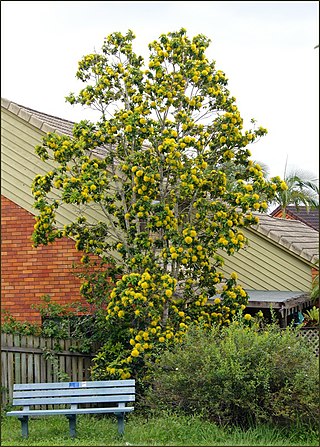
Vigna is a genus of plants in the legume family, Fabaceae, with a pantropical distribution. It includes some well-known cultivated species, including many types of beans. Some are former members of the genus Phaseolus. According to Hortus Third, Vigna differs from Phaseolus in biochemistry and pollen structure, and in details of the style and stipules.

Mucuna is a genus of around 114 accepted species of climbing lianas (vines) and shrubs of the family Fabaceae: tribe Phaseoleae, typically found in tropical and subtropical forests in the Americas, sub-Saharan Africa, southern, southeastern, and eastern Asia, New Guinea, Australia, and the Pacific Islands.

Acacia cultriformis, known as the knife-leaf wattle, dogtooth wattle, half-moon wattle or golden-glow wattle, is a perennial tree or shrub of the genus Acacia native to Australia. It is widely cultivated, and has been found to have naturalised in Asia, Africa, North America, New Zealand and South America. A. cultriformis grows to a height of about 4 m (13 ft) and has triangle-shaped phyllodes. The yellow flowers appear from August to November in its natural range. Its attractive foliage and bright flowers make it a popular garden plant.

Mucuna pruriens is a tropical legume native to Africa and tropical Asia and widely naturalized and cultivated. Its English common names include monkey tamarind, velvet bean, Bengal velvet bean, Florida velvet bean, Mauritius velvet bean, Yokohama velvet bean, cowage, cowitch, lacuna bean, and Lyon bean.

Hovea elliptica, commonly known as the tree hovea or karri blue bush, is an ornamental plant in the family Fabaceae that is native to Western Australia. This plant was cited as Hovea Celsi in Description des plantes rares cultivees a Malmaison et a Navarre by Aimé Jacques Alexandre Bonpland.

Acacia complanata, known as long-pod wattle and flat-stemmed wattle, is a perennial tree native to eastern Australia.

Archontophoenix cunninghamiana – commonly known as Bangalow palm, king palm, Illawara palm or piccabeen palm – is a tree in the palm family Arecaceae which is endemic to the east coast of New South Wales and Queensland, Australia.

Acacia myrtifolia, known colloquially as myrtle wattle, red stem wattle or red-stemmed wattle, is a species of Acacia native to coastal areas of southern and eastern Australia.

Xanthostemon chrysanthus, commonly known as golden penda, is a species of tree in the myrtle family Myrtaceae which is endemic to north eastern Queensland, Australia. It is a popular garden plant with showy yellow blooms, and is the floral emblem of the city of Cairns.

Hakea tephrosperma commonly known as hooked needlewood, is a shrub or small tree species in the family Proteaceae. It has cream flowers, needle-shaped leaves and is one of the taller species adaptable for dry to temperate locations.

Nymphaea gigantea, commonly known as the giant waterlily or blue waterlily, is a perennial, herbaceous plant in the family Nymphaeaceae which is native to parts of northern and eastern Australia, and it has been widely cultivated elsewhere. It is an aquatic plant whose natural habitat is permanent and semi-permanent still water bodies

Acacia aculeatissima, commonly known as thin-leaf wattle or snake wattle, is a shrub belonging to the genus Acacia and the subgenus Phyllodineae that is native to parts of eastern Australia.

Mucuna urens is a species of large liana from the family Fabaceae. The plant is native to tropical Central and South America, and has been introduced into the Republic of the Congo. Common names include horse-eye bean and ox-eye bean.
Mucuna paniculata is a species of flowering, woody vine in the family Fabaceae, the bean family. It is native to northern Madagascar where it is locally known in Malagasy as vohinkovika. It flowers between June and August.

Hydriastele wendlandiana, commonly known as Wendland's palm, cat o' nine tails, creek palm or kentia palm, is a tall, multi-stemmed tree in the palm family Arecaceae. It is native to New Guinea and the Australian states of Queensland and the Northern Territory.

Argophyllum curtum is a plant in the Argophyllaceae family endemic to a small part of north eastern Queensland. It was described and named in 2018.

Argophyllum palumense is a plant in the Argophyllaceae family endemic to a small part of north eastern Queensland. It was described and named in 2018.

Ormosia ormondii, commonly known as yellow bean, is a tree in the legume family Fabaceae which is endemic to northeastern Queensland, Australia.

Polhillides velutina is a species of flowering plant in the legume family, Fabaceae. It is the sole species in the genus Polhillides. It is an annual, perennial or sub-shrub, that is native to tropical regions of Africa and Madagascar, parts of Asia, New Guinea, and Australia. In Africa, its habitats include woodland and grassland in the Sudanian region, wooded grassland and grassland in the Victoria Basin forest–savanna mosaic, and wooded grassland and grassland in the Somalia-Masai region. It is found at elevations of up to 1,320 m (4,330 ft) above sea level.

Ryparosa kurrangii is a rare plant in the family Achariaceae which is endemic to a very small part of the Queensland tropical rain forests. It is a small tree growing under the rainforest canopy, producing its flowers and fruit on the lower part of the trunk. It was previously considered to be a form of the Ryparosa javanica complex of species.



























